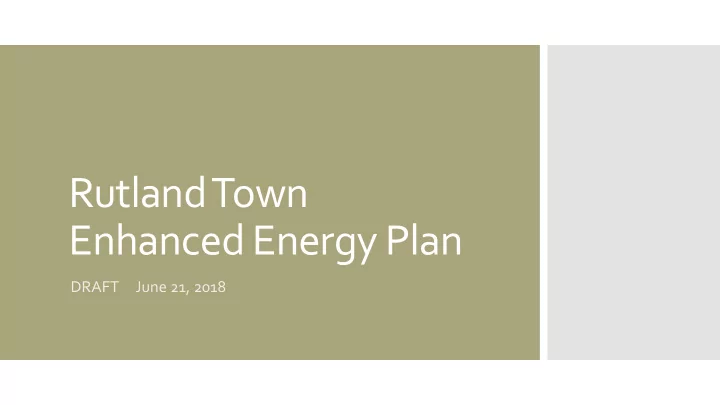

Rutland Town Enhanced Energy Plan DRAFT June 21, 2018
By 2050, 90% of energy comes from renewable sources Vermont Reduce greenhouse gas emissions to: Energy Goals 50% below 1990 levels by 2028; 75% below 1990 levels by 2050
Decrease overall energy consumption through In other words… Rutland Town conservation and efficiency Conservation & efficiency Reduce reliance on fossil Energy Goals fuels and imported energy Fuel switching & Policies sources Generation of energy Develop renewable energy resources locally
What control does one town have on overall energy use and Energy can be grouped into meeting the state’s goals? three major sectors: Energy 101 Transportation This plan lays out how towns can Heating & Cooling have an impact by concentrating on light-duty transportation, Electricity residential and commercial heating and electricity use.
Rutland Town will need to reduce overall energy use by half and nearly eliminate use of fossil fuels. By 2050, electric vehicles will need to comprise more than 90% of LEAP the light-duty fleet. modeling More than 90% of heating energy use will need to come from renewables. Continued commitment to conservation
Rutland Town’s Currently, Rutland Town has Renewable The town’s total renewable about 3.1 MW of total energy generation potential renewable energy Energy is 1,1016 MW. generation. Potential
Rutland Town’s The town’s target of 14,369 1,016 MW equals MWh by 2050 is a fraction of Renewable approximately 1,586,820 the town’s renewable MWh. generation potential of Energy Target 1,586,820 MWh.
Known Constraints (State) Vernal Pools DEC River Corridors Renewable FEMA Floodways Energy State – significant Natural Communities and Rare, Threatened, and Endangered Species Mapping National Wilderness Areas Class 1 and Class 2 Wetlands
Possible Constraints (State) Important Ag Soils FEMA Special Flood Hazard Areas Renewable Protected Lands Energy Act 250 Ag Soil Mitigation Areas Mapping Deer Wintering Areas ANR’s VT Conservation Highest Priority Forest Blocks Hydric Soils
Resources mapped Prime Resource Areas Wind* High resource potential; no Renewable Solar state Known Constraints Energy Biomass Hydro Secondary Resource Areas Mapping High resource potential; at least one state Possible * Utility scale wind is unsuitable Constraint for Rutland Town
Local Unsuitable Areas: Utility Scale Wind Renewable Energy Few of the prime areas identified could accommodate utility scale wind. Most are secondary resource areas and may not be suitable Mapping for energy development.
Local Possible Constraints Renewable Scenic Resources (pp 74-75) Energy Conservation District (ecological and/or aesthetic importance) Mapping Designated Rutland Town Historic Sites
Local Preferred Areas <150 kw – Residential and commercial rooftops (not mapped) Renewable >500 kw – Commercial scale Energy Foley/Baker parcels – 50 acres Mapping Municipal land at Northwood Park (capped former landfill) – 4 acres Route 7 Industrial Commercial District parcels – 181 acres
Department of Public Service Preferred Area s Renewable Roof-mounted systems Former brownfield sites Energy Disturbed areas (gravel/sand pits) Mapping Sanitary landfills Junkyards Parking lots
Rutland Town Renewable Energy Potential Summary Town Target (by 2050) (in MWh) 14,369 Total Acres in Rutland Town 12,292 Acres Suitable for Renewables 10,301 (Solar, Wind, Biomass – Prime and Secondary) Local Possible Constraints – Conservation District, Historic District (in 376 acres) Mapping Scenic Resources Areas * Summary Acres Suitable for Renewables (minus Constraints - in acres) 9,925 Local Preferred Areas (in acres) 94 Total Acres Suitable for Renewables (minus Constraints plus 10,019 Preferred Areas - in acres) Acres Needed to Make Target 84.8
Rutland Town Planning Commission Criteria for Net Metering Preferred Sites and Renewable Energy Siting Preferred Sites How Town Plans influence state regulatory proceedings: • Act 250 applications must conform to the municipal plan. • Applications for a Section 248 Certificate of Public Good must give due consideration to the municipal plan; with an enhanced energy plan considered compliant, it is substantial deference. Criteria: 1. Renewable energy generation potential is present on site (as indicated by the state’s data layers for prime and secondary resources). 2. Each proposed project is considered in a transparent and non-arbitrary manner and that each proposal is consistent with other land uses in that district as specified in the Municipal Plan and Future Land Use map. 3. If located in the AGR40 (Agricultural & Forestry Working Lands) District: The proposed project meets the definition of “lands presently used for or suitable to support agriculture, forestry, and related commercial, recreation and tourist related enterprises.” 4. If located in the AGR40 (Agricultural & Forestry Working Lands) District: The proposed project is considered small- scale commercial that “preserves the setting, natural features and contours of the land”. 5. If located in one of the town’s Scenic Resources (viewsheds) as specified in its Municipal Plan: The project does not have an “undue impact on the visual or scenic resources of other locations within the town from which it can be seen” using what’s known as the “ Quechee Analysis” legal precedent. 6. The site avoids environmentally-sensitive areas (wetlands, flood hazard areas, wildlife habitat). 7. The Town of Rutland has notified all abutting property owners and requested the developer to take all generally available and reasonable steps to mitigate the project’s visibility. 8. Access must be available to firefighters and other emergency responders as defined in the town’s Driveway Installations Ordinance, Article 1, § 181/20-24 (adopted in 1980).
Appointment of an Energy Coordinator and/or Energy Committee to be responsible for the implementation of strategies and policies for: Rutland Town Enhanced Conservation and Efficient Use of Energy Energy Plan Transportation Strategies & Policies to Land Use Achieve Town Targets
Recommend
More recommend